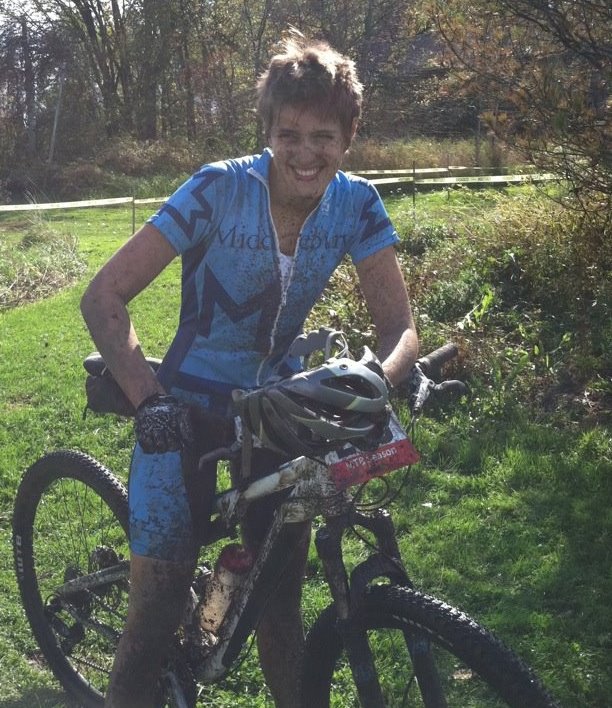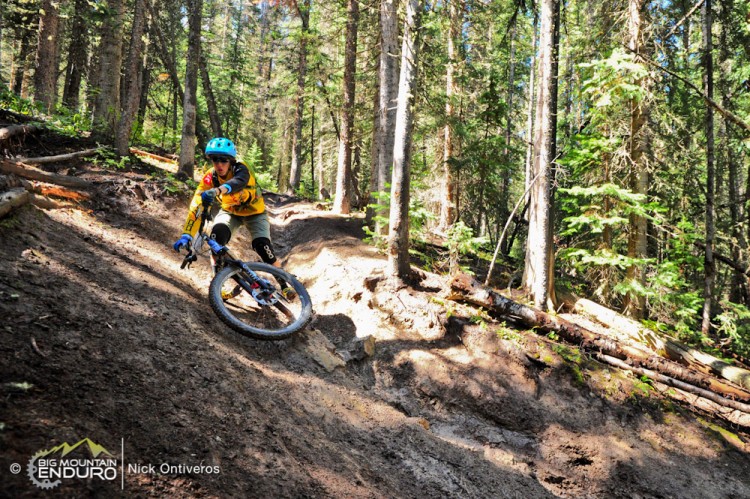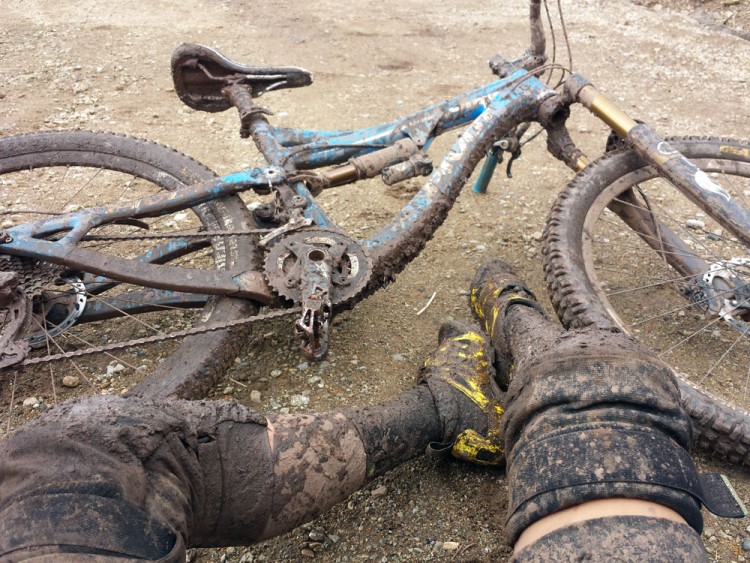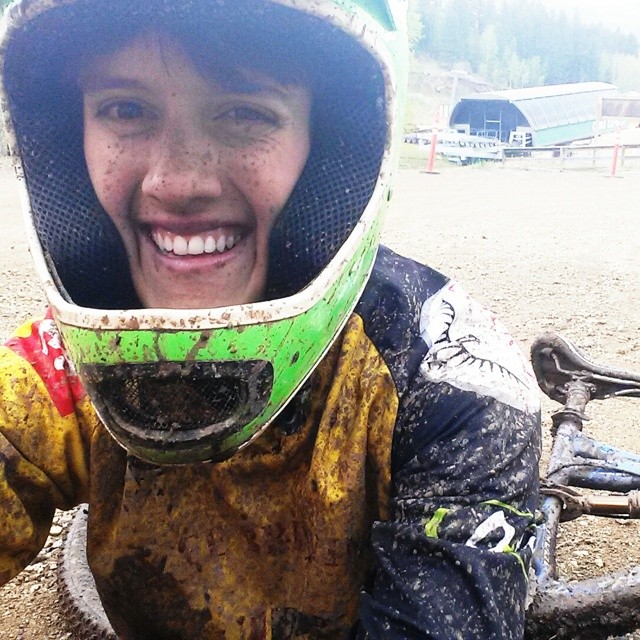My Complicated Relationship with Mud (and some tips for shredding wet trails)
22 Mar 2015
Ah, mud-riding. Another thing for the list of “things-I-really-should-be-good-at-but-totally-am-not.” Because, really, I should be good at riding wet stuff. I grew up in Southern Ohio, riding trails that were dry, like, maybe three weeks of the year. And then I went to school in Vermont and started racing mountain bikes at the collegiate level. There was one year where I’m pretty sure every single collegiate race was a mud bath. Like drivechain so clogged with mud that you can barely pedal and you have to replace pretty much everything afterwards. And I remember really enjoying this and actually winning a surprising amount of XC races. Look, here I am all covered in mud and stupidly happy about it, circa 2011.

Look ma, no knee pads!
So, what the hell changed? Here’s my grand theory (on mountain biking and life in general): if you don’t do a thing, you won’t be good at the thing. And sometimes the “thing” in question is annoyingly specific, like, in this case “riding a mountain bike down a steep, muddy, root-covered hillside at high speeds.” The fact that I’m relatively good at riding XC style trails at XC speeds in wet conditions has, in fact, been 0% helpful in racing enduro in the mud. I learned to go fast in New Mexico on dry, gravelly, baby heads. So, shocker, that’s what I’m good at going fast on. Give me ruts, give me sand, give me loose berms. But puhhhhhlease nothing wet.
The rules and tricks I picked up learning to ride relatively non-techy wet stuff have, if anything, proved counter-productive. For example, “avoid sideways roots when wet” is not terribly helpful when faced with a trail that is, in fact, nothing but wet, slippery, sideways roots. And “don’t use your brakes when on slippery surfaces” is equally unhelpful when the trail is extremely steep (and slippery) for extended periods of time and the steep bits tend to end in turns that you would inevitably overshoot if you just let go of the brakes.
This is about how well these rules worked for me on the one wet stage in Crested Butte last year:

Recently, I’ve been getting some proper practice riding gnarly wet stuff (Thanks Cyclone Pam!) and I’ve had some revelations. First off, it’s okay that I suck at this, because, seriously, I have never ridden anything like this. It would be like thinking I could race motocross just because I can make it to the grocery store and back on my parents’ 50cc scooter. Secondly, if it rains right before the Enduro World Series race this weekend, I may be better off ditching my bike and bringing a sled, because HOLY SHIT.
So, here goes. If you’re interested in learning along with me, here are my recently-acquired tips for riding scary things in the mud:
1. Trust your tires. So, by extension, invest in tires you can trust. Somehow I managed to make it until this week without ever really using a mud tire in the mud. I hadn’t really seen the point. {Yes, I’m a dumbass.} This week I had the dubious privilege of riding the steepest, rootiest, wettest trail in Rotorua twice, once with a Vittoria Tires Goma and once with Vittoria’s mud tire, the Jafaki. The Goma is an awesome tire. I rode it in every race last year. I love it and I would happily ride it forever and always because swapping tires is a pain in the ass. But it’s just not a mud tire. On round one down this trail I probably crashed 20 times. Both my tires were so gummed up you couldn’t even see the tread. I whacked my head on the ground. There *may* have been tears. Round two went a lot better. I actually had traction on some of the turns because the Jafaki sheds mud like a boss. I attempted everything and rode most of the trail and I only crashed around five times, which is way better than 20. So, tires matter.
2. Modulate your front/rear brakes. Riding in wet stuff requires that you pay way, way, way more attention to your brakes. I learned early on, as a 14-year-old riding slippery Ohio singletrack, to just never use my front brake. This was certainly the safest method. And since my speeds topped out at, like, 8 mph, this worked out pretty well. Fast forward 10 years and I have a 200mm front rotor, a 180mm rear, 2.4 tires with huge knobs and I often have to slam on both brakes as hard as possible to slow down enough to make a turn. Because I’m going that much faster. So, “don’t use your front brake” is another unhelpful tidbit. That said, riding steep, wet trails in Rotorua has forced me to re-evaluate my jam and slam technique and learn a more graceful “brake dance.” It goes like this — enter corner, use both brakes to scrub speed, begin turning, let off front brake and slam on the rear, let rear wheel slide all the way around, re-apply front brake (if necessary), exit corner. If there are roots in this corner (and there probably are), you’ll have to adjust this technique so that you’re off both the brakes when crossing the roots.

3. Embrace the slide, and then learn to control it. Sometimes you slide. Sometimes it’s just your rear tire sliding and this can actually be pretty helpful, assuming it’s sliding in the desired direction. Sometimes both of your tires are sliding and this is really pretty terrifying but doesn’t *always* mean you’re doomed. I have hardly mastered this, but the less I freak out when I slide, the better things seem to turn out. (This is applicable to pretty much everything in life, not just sliding.)
4. Accept that you’re not going to be clipped in. Sometimes pulling out a foot to dab is the best way to save a squirrelly corner without losing a ton of speed. This means you then have loads of mud stuck to your foot and you’re just not going to get back into your pedals before that next slippery roll-in. So jam your foot onto your pedal and hope for the best. It really will be okay.
5. Ride in the mud. I know, DUH. I contemplated putting “learn to read the terrain” as one of these tips but then I realized that the only way to accomplish that is just by doing it. Riding in the mud and doing everything wrong. Over and over again. Until you start to understand when to be light on your bike and when to be heavy, when to brake and when to definitely NOT brake. Going back to my grand theory, you will never be good at things you don’t do. So, do the things that scare you until they aren’t scary anymore. Do the things you’re bad at, even if you don’t want to. If a trail makes you cry and fall to pieces, go do it again. And again. And again. Improving isn’t pretty, but it’s fairly simple when you get right down to it.

I’m hardly an expert on this topic, so please feel free to chime in if you think I missed something important. I’d like to say that I’ve embraced the wet and that I won’t even care if it rains before this weekend’s race, but that’s hardly true. I’m still crossing my fingers for some hitherto unsuspected and seasonally improbable drought. Of course, it’s pouring rain as I type this, so it’s not looking good on that front. On the bright side, it looks like I’ll have ample opportunity to put my own tips to use. With any luck, I’ll finish in one piece, covered in mud, with a smile on my face.






I enjoy your writing style a lot! Good luck with all your races and travelling. Don’t change!